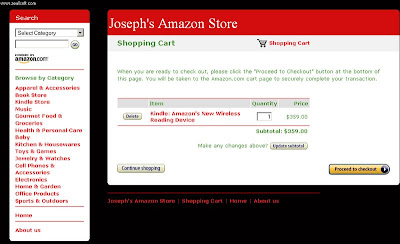 According to a market analysis released by the iPerceptions recently, there is a high abandon rate of online shopping cart. The report found that in the online traffic, there are 16% of people have the shopping will, but only half of those buy something, others give up.
According to a market analysis released by the iPerceptions recently, there is a high abandon rate of online shopping cart. The report found that in the online traffic, there are 16% of people have the shopping will, but only half of those buy something, others give up.In the 50000 respondents, 47% of these online users' main objectives are visit, survey and contrast products. In addition to shopping, the other motives include 11% of the people want to get the product price and promotion information, 10% need customer support services, 4% in order to find the address of the store, the other 10% of visitors are viewing blog and video.
An online shopping cart (also as online trolley, online shopping trolley, online shopping basket) is a critical aspect of en e-commerce business. The shopping cart is the software (or series of scripts) that allows users to select products from your Web site, save them and check out when they are done shopping. In the early stages of electronic shopping, the shopping cart was usually a basic HTML form from which a customer selected the products he wanted to purchase. Long before using a credit card over the Internet was widely accepted, it was common to find that you would need to print the form and mail it along with a money order or credit card information to the company. Over time, as e-commerce grew and online stores began to offer hundreds, if not hundreds of thousands of products, obviously a better method for storing a customer's purchases and placing an order was needed.
The shopping cart acts as the user-interface for the customer to shop. It allows users to place items in a "shopping basket". The cart remembers these items for a predetermined length of time, usually 15 to 30 days unless the shopper removes the items from the cart. Today's shopping carts are really designed for the ease-of-use of the shopper. Extra features such as different color or size options, quantity of order, and matching item links can be integrated into the shopping cart. Once a shopper enters her shipping address, taxes and shipping costs can also be tallied from within the shopping cart. For the merchant, the shopping cart also provides important information, which is often transparent to the shopper, including a cart number to track the order, and even a cookie to provide you with some limited tracking details about your customer.
Within the genre of shopping cart software, merchants have many options to choose from. Some shopping cart software is designed to run on your own Web server, while others may run on the application provider's (hosted) servers. It is important to remember that a shopping cart is just one part of the e-commerce Web site, and as a stand-alone tool it usually will not provide payment processing. Once the customer completes her "check-out", the shopping cart delivers the order to the payment gateway, the service that automates the payment transaction between the shopper and merchant. Shopping carts are not storefronts (although they are integrated into storefronts, which we will discuss later).
Originally Posted: China Business Daily
Author: Angulo Fu









